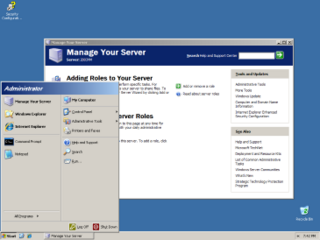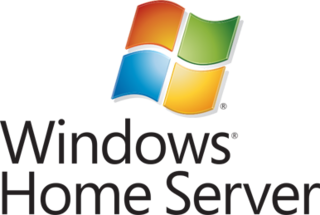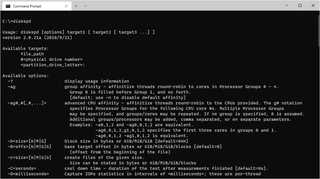
Microsoft Office, or simply Office, is a family of client software, server software, and services developed by Microsoft. It was first announced by Bill Gates on August 1, 1988, at COMDEX in Las Vegas. Initially a marketing term for an office suite, the first version of Office contained Microsoft Word, Microsoft Excel, and Microsoft PowerPoint. Over the years, Office applications have grown substantially closer with shared features such as a common spell checker, Object Linking and Embedding data integration and Visual Basic for Applications scripting language. Microsoft also positions Office as a development platform for line-of-business software under the Office Business Applications brand.

Disk partitioning or disk slicing is the creation of one or more regions on secondary storage, so that each region can be managed separately. These regions are called partitions. It is typically the first step of preparing a newly installed disk, before any file system is created. The disk stores the information about the partitions' locations and sizes in an area known as the partition table that the operating system reads before any other part of the disk. Each partition then appears to the operating system as a distinct "logical" disk that uses part of the actual disk. System administrators use a program called a partition editor to create, resize, delete, and manipulate the partitions. Partitioning allows the use of different filesystems to be installed for different kinds of files. Separating user data from system data can prevent the system partition from becoming full and rendering the system unusable. Partitioning can also make backing up easier. A disadvantage is that it can be difficult to properly size partitions, resulting in having one partition with too much free space and another nearly totally allocated.

Windows Server 2003, codenamed "Whistler Server", is the sixth version of the Windows Server operating system produced by Microsoft. It is part of the Windows NT family of operating systems and was released to manufacturing on March 28, 2003 and generally available on April 24, 2003. Windows Server 2003 is the successor to the Server editions of Windows 2000 and the predecessor to Windows Server 2008. An updated version, Windows Server 2003 R2, was released to manufacturing on December 6, 2005. Windows Server 2003 is based on Windows XP.
In computing, a hard link is a directory entry that associates a name with a file. Thus, each file must have at least one hard link. Creating additional hard links for a file makes the contents of that file accessible via additional paths. This causes an alias effect: a process can open the file by any one of its paths and change its content. By contrast, a soft link or “shortcut” to a file is not a direct link to the data itself, but rather a reference to a hard link or another soft link.

Total Commander is an orthodox file manager, i.e. it features two file list panels and a command line. It supports multiple tabs for each panel.

In computing, a file system or filesystem governs file organization and access. A local file system is a capability of an operating system that services the applications running on the same computer. A distributed file system is a protocol that provides file access between networked computers.
Filesystem in Userspace (FUSE) is a software interface for Unix and Unix-like computer operating systems that lets non-privileged users create their own file systems without editing kernel code. This is achieved by running file system code in user space while the FUSE module provides only a bridge to the actual kernel interfaces.
Veritas Backup Exec is a data protection software product designed for customers with mixed physical and virtual environments, and who are moving to public cloud services. Supported platforms include VMware and Hyper-V virtualization, Windows and Linux operating systems, Amazon S3, Microsoft Azure and Google Cloud Storage, among others. All management and configuration operations are performed with a single user interface. Backup Exec also provides integrated deduplication, replication, and disaster recovery capabilities and helps to manage multiple backup servers or multi-drive tape loaders.
A system profiler is a program that can provide detailed information about the software installed and hardware attached to a computer. Typically workstations and personal computers have had system profilers as a common feature since the mid-1990s.

Microsoft Drive Optimizer is a utility in Microsoft Windows designed to increase data access speed by rearranging files stored on a disk to occupy contiguous storage locations, a technique called defragmentation. Microsoft Drive Optimizer was first officially shipped with Windows XP.
Single-instance storage (SIS) is a system's ability to take multiple copies of content and replace them by a single shared copy. It is a means to eliminate data duplication and to increase efficiency. SIS is frequently implemented in file systems, e-mail server software, data backup, and other storage-related computer software. Single-instance storage is a simple variant of data deduplication. While data deduplication may work at a segment or sub-block level, single-instance storage works at the whole-file level and eliminates redundant copies of entire files or e-mail messages.

Windows Home Server is a home server operating system from Microsoft. It was announced on 7 January 2007 at the Consumer Electronics Show by Bill Gates, released to manufacturing on 16 July 2007 and officially released on 4 November 2007.
Windows Vista contains a range of new technologies and features that are intended to help network administrators and power users better manage their systems. Notable changes include a complete replacement of both the Windows Setup and the Windows startup processes, completely rewritten deployment mechanisms, new diagnostic and health monitoring tools such as random access memory diagnostic program, support for per-application Remote Desktop sessions, a completely new Task Scheduler, and a range of new Group Policy settings covering many of the features new to Windows Vista. Subsystem for UNIX Applications, which provides a POSIX-compatible environment is also introduced.
Microsoft SQL Server Compact is a discontinued relational database produced by Microsoft for applications that run on mobile devices and desktops. Prior to the introduction of the desktop platform, it was known as SQL Server for Windows CE and SQL Server Mobile Edition.
This is a comparison of online backup services.
Side-by-side assembly technology is a standard for executable files in Windows 98 Second Edition, Windows 2000, and later versions of Windows that attempts to alleviate problems that arise from the use of dynamic-link libraries (DLLs) in Microsoft Windows. Such problems include version conflicts, missing DLLs, duplicate DLLs, and incorrect or missing registration. In side-by-side, Windows stores multiple versions of a DLL in the %systemroot%\WinSxS directory, and loads them on demand. This reduces dependency problems for applications that include a side-by-side manifest.
A disk utility is a utility program that allows a user to perform various functions on a computer disk, such as disk partitioning and logical volume management, as well as multiple smaller tasks such as changing drive letters and other mount points, renaming volumes, disk checking, and disk formatting, which are otherwise handled separately by multiple other built-in commands. Each operating system (OS) has its own basic disk utility, and there are also separate programs which can recognize and adjust the different filesystems of multiple OSes. Types of disk utilities include disk checkers, disk cleaners and disk space analyzers

DiskSpd is a free and open-source command-line tool for storage benchmarking on Microsoft Windows that generates a variety of requests against computer files, partitions or storage devices and presents collected statistics as text in the command-line interface or as an XML file.

MSP360, formerly CloudBerry Lab, is a software and application service provider company that develops online backup, remote desktop and file management products integrated with more than 20 cloud storage providers.









